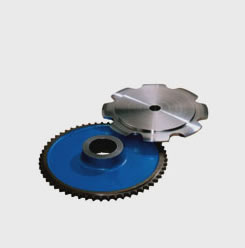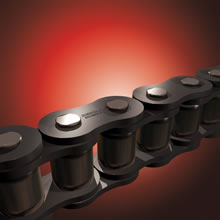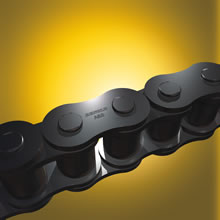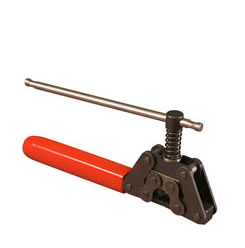Sprockets
Renold offer a comprehensive range of transmission chain sprockets for British Standard chain up to two inch pitch, ensuring maximum working life and productivity for your application. Other sizes of sprocket, including those to American Standard dimensions, are available on request.
Special sprockets are also manufactured on request, in special materials or formats, normally to suit a specific applications in harsh or difficult drive situations, such as;
- Sprockets incorporating shafts
- Welded or detachable hubs
- Shear pin devices fitted
- Necklace sprockets made up of chain plates and individual tooth sections for turning large drums or tables.
- Combination sprockets (two or more sprockets combined having different pitch sizes and numbers of teeth).
- Sprockets in two or more sections, i.e. split sprockets or segmental sprockets.
Sprocket and Chain Compatibility
Most drives have an uneven number of pitches in the chain and by using a driver sprocket with an odd number of teeth, uniform wear distribution over both chain and sprocket teeth is ensured. Even numbers of teeth for both the driver and the driven sprockets can be used, but wear distribution on both the sprocket teeth and chain is poor.
Number of Teeth
The maximum number of teeth in any driven sprocket should not exceed 114. This limitation is due to the fact that for a given elongation of chain due to wear, the working pitch diameter of the chain on the sprocket increases in relation to the nominal pitch diameter, i.e. the chain assumes a higher position on the sprocket tooth. The allowable safe chain wear is considered to be in the order of 2% elongation over nominal length.
A simple formula for determining how much chain elongation a sprocket can accommodate is 200/N expressed as a percentage where N is the number of teeth on the largest sprocket in the drive system. It is good practice to have the sum of teeth not less than 50 where both the driver and the driven sprockets are operated by the same chain, e.g. on a 1:1 ratio drive. Both sprockets should have 25 teeth each.
Centre Distance
For optimum wear life, centre distance between two sprockets should normally be within the range 30 to 50 times the chain pitch. On drive proposals with centre distances below 30 pitches or greater than 2 metres, we would recommend that the drive details are discussed with our technical staff.
The minimum centre distance is sometimes governed by the amount of chain lap on the driver sprocket, our normal recommendation in this circumstance being not less than six teeth in engagement with the chain.
The centre distance is also governed by the desirability of using a chain with an uneven number of pitches to avoid the use of a cranked link, a practice that is not recommended except in special circumstances.
For a drive in the horizontal plane, the shortest centre distance possible should be used consonant with recommended chain lap (maximum six teeth) on the driver sprocket.
|
SPROCKET |
SMOOTH |
MODERATE SHOCKS |
HEAVY |
|
UP TO 29T |
EN8 |
EN8 or EN9 Hardened and Tempered or Case Hardened |
EN8 or EN9 |
|
30T AND OVER |
Cast Iron |
Mild Steel or Meehanite |
EN8 or EN9 |



